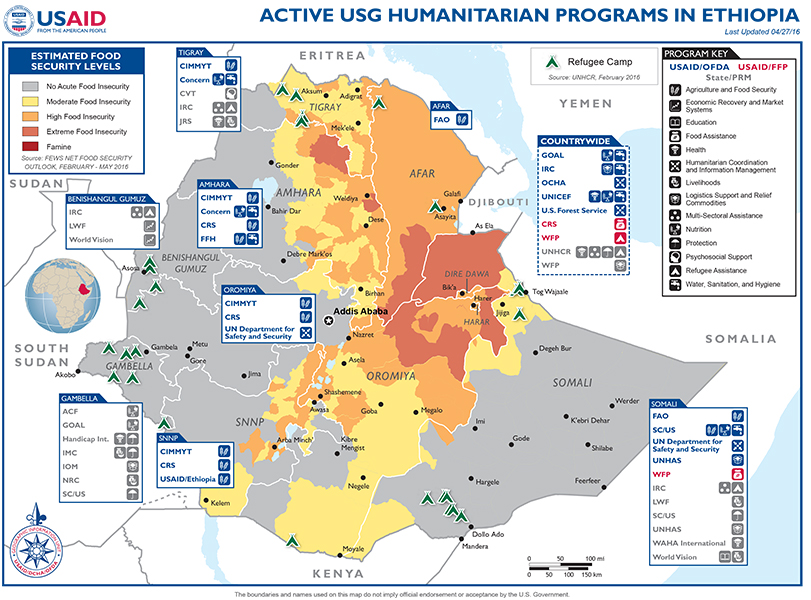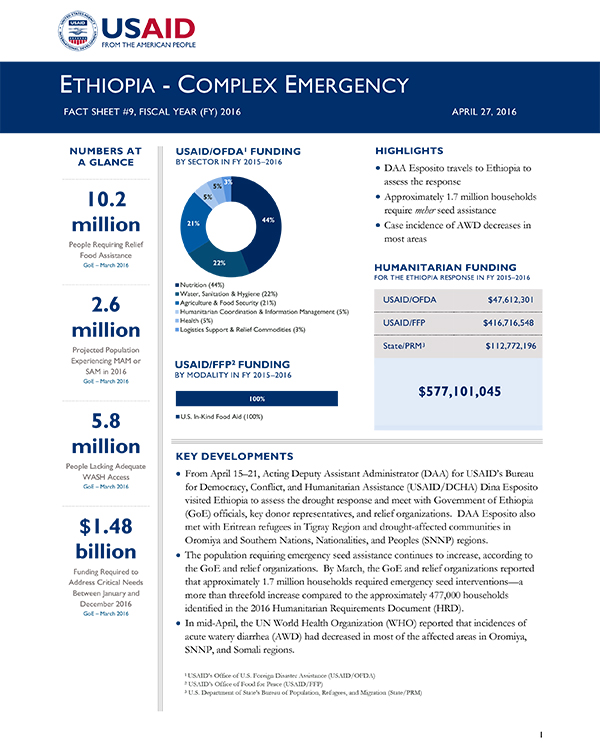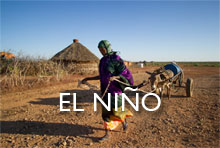- What We Do
- Agriculture and Food Security
- Democracy, Human Rights and Governance
- Economic Growth and Trade
- Education
- Ending Extreme Poverty
- Environment and Global Climate Change
- Gender Equality and Women's Empowerment
- Global Health
- Water and Sanitation
- Working in Crises and Conflict
- Disaster Assistance
- Political Transition Initiatives
- Conflict Mitigation and Prevention
- Countering Violent Extremism
- Disaster Risk Reduction
- Peacebuilding and Reconciliation
- Providing Safe & Secure Environments for Development
- Recovering From Crisis
- Resilience
- Tech Challenge for Atrocity Prevention
- World Humanitarian Day
- U.S. Global Development Lab
April 27, 2016
Highlights
DAA Esposito travels to Ethiopia to assess the response
Approximately 1.7 million households require meher seed assistance
Case incidence of AWD decreases in most areas
Key Developments
Ethiopia Map - 04-27-2016 ![]() (pdf - 1 MB)
(pdf - 1 MB)
Numbers At A Glance
10.2 million
2.6 million
5.8 million
$1.48 billion
Humanitarian Funding
For the Ethiopia Response
FY 2015 - 2016
| USAID/OFDA | $47,612,301 |
| USAID/FFP | $416,716,548 |
| State/PRM | $113,772,196 |
| TOTAL | $577,101,045 |
From April 15–21, Acting Deputy Assistant Administrator (DAA) for USAID’s Bureau for Democracy, Conflict, and Humanitarian Assistance (USAID/DCHA) Dina Esposito visited Ethiopia to assess the drought response and meet with Government of Ethiopia (GoE) officials, key donor representatives, and relief organizations. DAA Esposito also met with Eritrean refugees in Tigray Region and drought-affected communities in Oromiya and Southern Nations, Nationalities, and Peoples (SNNP) regions.
The population requiring emergency seed assistance continues to increase, according to the GoE and relief organizations. By March, the GoE and relief organizations reported that approximately 1.7 million households required emergency seed interventions—a more than threefold increase compared to the approximately 477,000 households identified in the 2016 Humanitarian Requirements Document (HRD).
In mid-April, the UN World Health Organization (WHO) reported that incidences of acute watery diarrhea (AWD) had decreased in most of the affected areas in Oromiya, SNNP, and Somali regions.
CURRENT EVENTS
USAID/DCHA Acting DAA Esposito visited Ethiopia from April 15–21 to assess the drought response and meet with GoE officials, key donor representatives, and humanitarian organizations. DAA Esposito also traveled to drought-affected communities in Oromiya and SNNP and met with Eritrean refugees in Tigray.
Members from the USAID Disaster Assistance Response Team (DART) traveled with the DAA to Hitsats refugee camp in Tigray and evaluated the progress of refugee biometric registration at the site. DAA Esposito and the DART also engaged with refugees and relief organization staff—primarily from the UN World Food Program (WFP) and the Office of the UN High Commissioner for Refugees (UNHCR)—regarding ongoing food assistance and other humanitarian interventions, as well as protection and livelihoods concerns and refugee relationships with the host community.
The DAA also observed USAID partner GOAL’s emergency nutrition activities in Oromiya’s Siraro District. Since March 2015, USAID/OFDA has supported GOAL to operate outpatient therapeutic feeding and stabilization centers in the district to treat children experiencing severe acute malnutrition, as well as train health care workers in management and treatment of acute malnutrition.
In Oromiya’s Arsi Zone, DAA Esposito and the DART observed relief food assistance distributions under the USAID/FFP-funded, Catholic Relief Services (CRS)-led Joint Emergency Operation (JEOP). Through a local CRS partner, JEOP is providing relief food assistance to more than 269,000 people across five woredas, or districts, in Oromiya where drought-affected populations experienced complete crop failure during the 2015/2016 meher harvest. DAA Esposito also visited USAID/FFP-supported Development Food Assistance Program (DFAP) activities under the GoE-led Productive Safety Net Program (PSNP). The PSNP provided cash or food assistance to more than 11,400 people in the zone following their participation in public works programs aimed at improving natural resource management.
In Oromiya’s Arsi Negele District, DAA Esposito and the DART observed USAID-funded Graduation with Resilience to Achieve Sustainable Development (GRAD) activities implemented by non-governmental organization (NGO) CARE under the U.S. Government (USG) Feed the Future Initiative. During the visit, GRAD beneficiaries shared how multiple coping strategies—including income diversification, increased savings, and improved access to finance and social capital—had bolstered community resilience against drought-related impacts.
FOOD SECURITY
As of April 13, the GoE and relief organizations had distributed approximately 88 percent of the first round of 2016 relief food distributions, according to WFP. In addition, the GoE and relief actors had distributed approximately 35 percent of the second round, while third round relief food distributions had not yet begun; the fourth and fifth rounds of relief food assistance distributions are expected to start in May and June, respectively.
To date in Fiscal Year (FY) 2016, USAID/FFP has provided more than $267 million to support food security in Ethiopia. USAID/FFP funding supports relief food distributions to drought-affected communities through WFP and the JEOP.
AGRICULTURE
According to the GoE, seed reserves in Ethiopia are severely depleted, and nearly 1.7 million households require seed assistance for the June-to-August meher planting season—an increase of nearly 103 percent from the 838,000 households in January and a more than 250 percent increase from the 477,000 household figure reported in December 2015. Food insecurity, high food prices, and diminishing purchasing power have forced some households to consume their remaining stored seed as food, USAID/OFDA partner the UN Food and Agriculture Organization (FAO) reports.
High livestock mortality rates and deteriorating livestock body conditions—due to inadequate grazing resources, feed shortages, and limited water availability—have led to a decline in milk and meat production and increased incidence of livestock disease and death, the UN agency reports. Approximately 654,000 livestock-dependent households require animal feed support.
NUTRITION AND WASH
From April 23–24, DART members—including a water, sanitation, and hygiene (WASH) specialist—assessed humanitarian conditions and WASH emergency response efforts in three districts of SNNP. During the visit, the DART observed multiple water point rehabilitation activities by USAID/OFDA partner the International Rescue Committee (IRC). The DART members also noted widespread land preparation activities for the planting season, with a majority of animals, such as oxen, appearing healthy. Following the onset of February-to-June belg rains in the region, soil moisture levels appeared normal.
Additionally, from April 13–19, DART members traveled to Afar, Amhara, and Tigray regions to meet with local GoE officials, assess WASH conditions, and evaluate humanitarian coordination efforts and the WASH response.
In Afar’s Berhale and Galaeso towns, the DART observed USAID/OFDA-supported WASH interventions—including rehabilitation of water points and installation of water tanks—under the IRC-managed WASH rapid response fund. In Berhale, community members reported that extended drought conditions had resulted in the deaths of more than 50 percent of the area’s livestock, prompting some people to relocate livestock to the eastern Tigray highlands to access feed, fodder, and water. In addition, community members in Galaeso reported receiving distributions of GoE-supported relief food assistance, although some people noted that food rations were insufficient to meet needs. Recent rainfall has increased access to safe drinking water in each town, but significant food security and WASH challenges remain.
The DART also visited Amhara’s Bugna and Lasta districts, where the IRC-managed rapid response fund is delivering life-saving WASH assistance—including provision of safe drinking water via water trucking, rehabilitation of water points, and scabies reduction efforts—to drought-affected populations. At schools in each district, trucks are delivering safe drinking water to beneficiaries. The DART noted long lines of empty water containers at each distribution point, attesting to the severe water shortages in the area. Women in the community reported that traditional water sources had dried up and that community members had walked three hours each way to obtain safe drinking water prior to the beginning of water-trucking services in the area. Community members lack seed for the meher planting season and plan to sell assets to procure necessary seed. Farmers have begun to plough their land in preparation for the upcoming meher season. People without oxen will likely borrow animals from others, with promises of payment in produce or labor.
In Tigray’s Mekele town, local GoE officials reported adequate water-trucking services, with more than 50 trucks operating in drought-affected areas of the region; however, the officials called for additional investment to treat safe drinking water, support drilling systems, and boost the capacity of regional GoE officials.
HEALTH
As of mid-April, incidents of AWD were decreasing in most of the 15 affected areas in Oromiya, SNNP, and Somali regions, except in Oromiya’s Guji Zone, WHO reports. According to the UN agency, health officials had reported more than 1,340 AWD cases and 14 AWD deaths as of April 13. In response to the incidences of AWD and a potential for a resurgence in cases, WHO has initiated a training-of-trainers on early warning and response systems in priority districts to support the existing public health emergency management system in providing real-time surveillance data to promote early detection of disease outbreaks and strengthen emergency nutritional surveillance, the UN Office for the Coordination of Humanitarian Affairs (OCHA) reports.
Following a facility-based rapid assessment in five drought-affected districts of Somali’s Sitti Zone, the UN Population Fund (UNFPA) provided medical supplies and equipment—comprising 2,800 packets of iron folate, 2,600 delivery kits, and 1,500 dignity kits—to four health centers in the zone on April 11.
INTERNATIONAL HUMANITARIAN ASSESSMENTS
On April 25, the European Commissioner for International Cooperation and Development Neven Mimica announced an additional $467 million to support El Niño-affected countries, including Ethiopia. Since December 2015, the EU has provided approximately $608 million to El Niño response efforts.
Following a visit to Ethiopia by Government of Germany (GoG) Parliamentary State Secretary Thomas Silberhorn in late April, the GoG announced nearly $11.3 million in funding to the UN Children’s Fund (UNICEF) to help treat acutely malnourished children.
GoE officials and UN representatives commenced a donor capital visits in Oslo, Norway, on April 26 to raise awareness on the urgent need for increased humanitarian funding to respond to Ethiopia’s ongoing drought. The tour will also include visits to Washington, D.C., and New York City, New York.
CONTEXT
Multiple consecutive seasons of below-normal rainfall and the current effects of the El Niño have resulted in deteriorating agricultural, livestock, food security, and nutrition conditions in northeastern and central Ethiopia. By December 2015, the GoE estimated that 10.2 million people required relief food assistance and other humanitarian interventions during 2016.
USAID activated a DART on February 24, 2016, to lead the USG crisis response to the drought in Ethiopia. In support of the GoE, the DART is coordinating USG response activities in close partnership with the UN and other relief organizations. The DART—composed of humanitarian specialists based in Ethiopia—is addressing critical needs and examining ways to realign activities to respond to urgent assistance gaps. USAID also established an Ethiopia Drought Response Management Team based in Washington, D.C., to support emergency response efforts in Ethiopia.
While drought remains a major contributor to vulnerability in Ethiopia, negatively affecting the lives and livelihoods of farmers and pastoralists, populations also continue to confront other challenges—including seasonal flooding, localized intercommunal conflict, above-average food prices, disease outbreaks, and limited access to health and WASH services—that contribute to sustained humanitarian needs and an ongoing complex emergency in Ethiopia.
On October 7, 2015, U.S. Chargé d’Affaires, a.i., Peter H. Vrooman redeclared a disaster for Ethiopia in response to the ongoing complex emergency.
PUBLIC DONATION INFORMATION
The most effective way people can assist relief efforts is by making cash contributions to humanitarian organizations that are conducting relief operations. A list of humanitarian organizations that are accepting cash donations for disaster responses around the world can be found at www.interaction.org.
USAID encourages cash donations because they allow aid professionals to procure the exact items needed (often in the affected region); reduce the burden on scarce resources (such as transportation routes, staff time, and warehouse space); can be transferred very quickly and without transportation costs; support the economy of the disaster-stricken region; and ensure culturally, dietary, and environmentally appropriate assistance.
More information can be found at:
- USAID Center for International Disaster Information: www.cidi.org or +1.202.821.1999.
- Information on relief activities of the humanitarian community can be found at www.reliefweb.int.










Comment
Make a general inquiry or suggest an improvement.